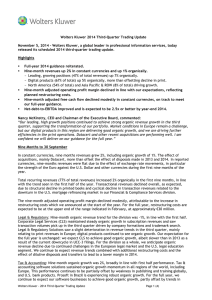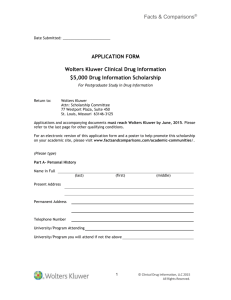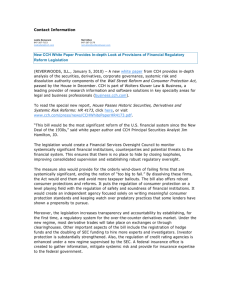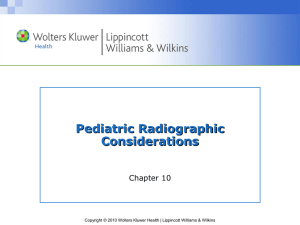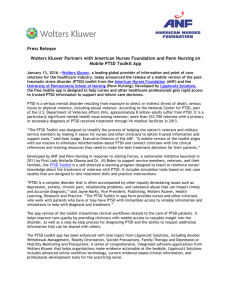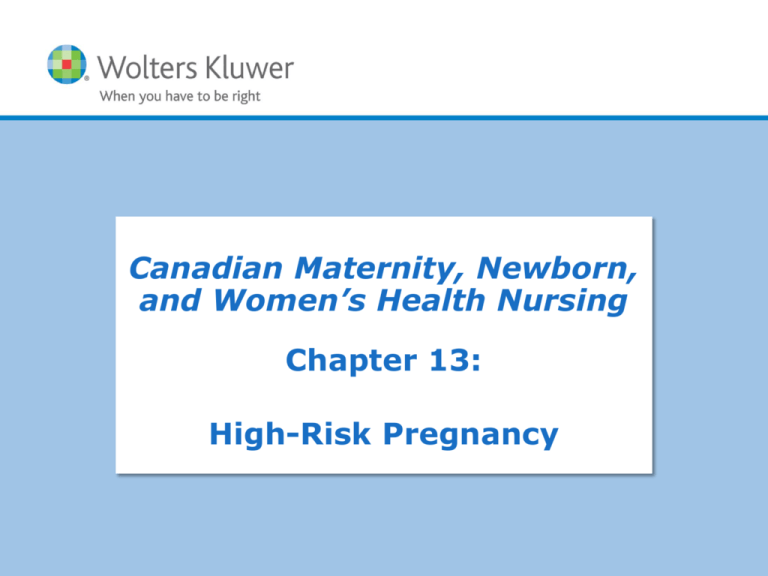
Canadian Maternity, Newborn,
and Women’s Health Nursing
Chapter 13:
High-Risk Pregnancy
Copyright © 2010 Wolters Kluwer Health | Lippincott Williams & Wilkins
Pregnancy Risk Assessment
• Psychosocial
• Economic
• Nutrition-related
• Family-related considerations
Copyright © 2015 Wolters Kluwer • All Rights Reserved
Health Complications in Pregnancy
• Asthma
– Labour: assess vital signs; shortness of
breath, increased respiratory rate, inspiratory
and expiratory effort, oxygen saturation
– Asthma medicine; avoid Demerol or morphine
– Aim for adequate respiratory function; ability
to cope with labour and birth; verbalize
understanding of and fetal well-being;
consistency of care
Copyright © 2015 Wolters Kluwer • All Rights Reserved
Health Complications in Pregnancy (cont.)
• Cystic fibrosis
− Observe for signs of malabsorption;
monitor maternal weight and pancreatic
enzymes, fluid and electrolyte balance;
assess results of laboratory testing;
adequate oxygenation
− Oral supplements, pulse oximetry, oxygen
if required; breastfeeding permitted once
sodium content has been determined
Copyright © 2015 Wolters Kluwer • All Rights Reserved
Health Complications in Pregnancy (cont.)
• Cardiovascular disease
– Types
o Class I: angina during strenuous or
prolonged activity
o Class II: angina during vigorous activity
o Class III: symptoms with daily activities
o Class IV: symptomatic when resting
Copyright © 2015 Wolters Kluwer • All Rights Reserved
Health Complications in Pregnancy (cont.)
• Cardiovascular disease (cont.)
− Mitral stenosis
− Mitral valve prolapse
− Peripartum cardiomyopathy
− Atrial septal defects
Copyright © 2015 Wolters Kluwer • All Rights Reserved
Health Complications in Pregnancy (cont.)
• Cardiovascular disease (cont.)
– Collaborative management: pregnancy
o Physical examination, chest x-ray, ECG,
blood gas analysis, echocardiogram
o Activity restriction, rest, iron
supplementation; monitoring of mother
and fetus
o Aim for adequate ventilation, tissue
perfusion, hydration
Copyright © 2015 Wolters Kluwer • All Rights Reserved
Health Complications in Pregnancy (cont.)
• Cardiovascular disease (cont.)
– Collaborative management: labour and birth
o Vital signs; fatigue, difficulty breathing or
shortness of breath, palpitations, swollen
feet
o Reduce cardiac workload; goal is vaginal
birth after 36 weeks’ gestation;
hemodynamic monitoring, urine output, fetal
monitoring
Copyright © 2015 Wolters Kluwer • All Rights Reserved
Health Complications in Pregnancy (cont.)
• Anemia
– Iron-deficiency anemia
o Assess hemoglobin, hematocrit,
serum ferritin, free erythrocyte
protoporphyrin
o Dietary review; prenatal vitamins,
adequate iron; financial discussion
regarding affordable diet
Copyright © 2015 Wolters Kluwer • All Rights Reserved
Health Complications in Pregnancy (cont.)
• Anemia (cont.)
– Sickle cell anemia
o Health history, blood count, reticulocyte
count, blood urea nitrogen, glucose,
direct bilirubin, urinalysis
o Folic acid supplementation
o Sickle cell crisis: acute episode of
vascular occlusion
Copyright © 2015 Wolters Kluwer • All Rights Reserved
Health Complications in Pregnancy (cont.)
• Autoimmune diseases
– Systemic lupus erythematosus
o Frequent prenatal visits; monitor renal
function, blood pressure, fetal health
o Corticosteroid therapy
o Labour: blood pressure, edema, proteinuria,
urine output, cardiac monitoring, lung
sounds, blood counts, fetal monitoring
o May need cesarean delivery
Copyright © 2015 Wolters Kluwer • All Rights Reserved
Health Complications in Pregnancy (cont.)
• Autoimmune diseases (cont.)
– Antiphospholipid syndrome
o Recurrent spontaneous abortions,
unexplained pregnancy loss in second or
third trimester, venous thrombosis, arterial
thrombosis, stroke, SLE, autoimmune
thrombocytopenia, prolonged clotting assay
o Treatment: prednisone with low-dose
aspirin; low-molecular-weight heparin
Copyright © 2015 Wolters Kluwer • All Rights Reserved
Health Complications in Pregnancy (cont.)
• Infections
– HIV: test during pregnancy for early diagnosis
and treatment of newborn
o Teach risks and benefits of care; determine
level of knowledge about disease; plan for
the newborn
o Assess emotional state and ability to cope
o Goal is to reduce maternal viral load before
delivery; might have cesarean birth
Copyright © 2015 Wolters Kluwer • All Rights Reserved
Health Complications in Pregnancy (cont.)
• Infections (cont.)
– HIV (cont.)
o Therapy: start antiretroviral drug during
pregnancy; give intravenously during
labour and birth
o Test for HIV in newborn; ongoing medical
treatment will be an extension of the
care started during pregnancy
Copyright © 2015 Wolters Kluwer • All Rights Reserved
Health Complications in Pregnancy (cont.)
• Infections (cont.)
– Sexually transmitted infections (STIs)
o Prenatal care: inquire about sexual
activity, previous STIs, risk factors
o Physical examination
o Screening, treatment, and follow-up
throughout pregnancy
Copyright © 2015 Wolters Kluwer • All Rights Reserved
Health Complications in Pregnancy (cont.)
• Infections (cont.)
– Group B streptococcus
o Prenatal: swab at 35 to 37 weeks; if
positive, need antibiotics at least 4 hours
before birth
– Rubella
o Screen for rubella immunity at first prenatal
visit; if no immunity, counsel to avoid
contact with children who have not been
immunized
Copyright © 2015 Wolters Kluwer • All Rights Reserved
Question
• A client develops a rash on her face, and rubella is
suspected. Which transmission-based precautions
would the nurse use when caring for this client?
a) Contact precautions
b) Droplet precautions
c) Airborne precautions
Copyright © 2015 Wolters Kluwer • All Rights Reserved
Answer
b) Droplet precautions
– Transmission of rubella is by droplet.
Symptoms of rubella infection include a rash
that may or may not be itchy that begins on the
face and progresses to the trunk.
Copyright © 2015 Wolters Kluwer • All Rights Reserved
Health Complications in Pregnancy (cont.)
• Infections (cont.)
– Toxoplasmosis: thorough cooking of meat;
avoid cat feces; use gloves when gardening;
treat with spiramycin
– Cytomegalovirus: avoid contact with children
in daycare or health care settings; encourage
frequent hand washing
– Parvovirus: transmission by inhaled particles,
hand-to-mouth contact, contaminated blood
Copyright © 2015 Wolters Kluwer • All Rights Reserved
Health Complications in Pregnancy (cont.)
• Renal and urinary problems
– UTIs and pyelonephritis
o Recognize difference between UTI and
normal pregnancy changes
o Pyelonephritis: costovertebral angle
tenderness, high fever, chills, myalgia,
nausea, vomiting
o Antibiotics and antimicrobial agents
o Hygiene: wipe from front to back after
urination and intercourse; extra fluid
intake; cotton underwear
Copyright © 2015 Wolters Kluwer • All Rights Reserved
Health Complications in Pregnancy (cont.)
• Renal and urinary problems (cont.)
– Acute renal failure
o Sudden decrease in renal function
o Thorough health history and physical
examination; vital signs; blood count,
electrolytes, coagulation profile
o Fetal monitoring
Copyright © 2015 Wolters Kluwer • All Rights Reserved
Health Complications in Pregnancy (cont.)
• Diabetes mellitus
– May be pre-existing or gestational
– Potential nursing diagnosis
o Anxiety
o Deficient knowledge
o Risk for ineffective health
maintenance
o Imbalanced nutrition
o Ineffective coping
Copyright © 2015 Wolters Kluwer • All Rights Reserved
Health Complications in Pregnancy (cont.)
• Diabetes mellitus (cont.)
– Review or teach blood glucose selfmonitoring
– Promote diet management
– Encourage activity and exercise
– Administer insulin
– Monitor the fetus
– Provide care during labour and birth
Copyright © 2015 Wolters Kluwer • All Rights Reserved
Psychosocial Disorders and Problems
• Depression
– Changes in mood, sleep patterns,
appetite, weight; feelings of helplessness
– Counselling, medications
• Bipolar disorder
– Cyclic patterns of depression and mania
– Medications may be teratogenic
Copyright © 2015 Wolters Kluwer • All Rights Reserved
Psychosocial Disorders and Problems
(cont.)
• Intimate-partner violence
– May begin or increase during pregnancy
– Screen for suggestive indicators
– Nonthreatening, nonjudgemental
approach
– SOS: Screen, Offer options, Safety
Copyright © 2015 Wolters Kluwer • All Rights Reserved
Psychosocial Disorders and Problems
(cont.)
• Intimate-partner violence (cont.)
– Potential nursing diagnoses:
o Fear
o Anxiety
o Chronic pain
o Deficient knowledge
o Pain
o Impaired parenting
Copyright © 2015 Wolters Kluwer • All Rights Reserved
Psychosocial Disorders and Problems
(cont.)
• Intimate-partner violence (cont.)
– Emergency safety plan; treat with respect and
dignity; one-to-one nursing care
– Provide encouragement and support;
information about community resources and
shelters; ensure safety and well-being of
mother and fetus
Copyright © 2015 Wolters Kluwer • All Rights Reserved
Psychosocial Disorders and Problems
(cont.)
• Substance use
– Tobacco, alcohol, marijuana, cocaine,
alcohol, opioids
– Methadone treatment in perinatal period
• Eating disorders
– Anorexia, bulimia
Copyright © 2015 Wolters Kluwer • All Rights Reserved
Obesity and Pregnancy
• Obesity
–
Increased risk of hypertension,
vascular disease, diabetes,
cesarean birth
– Increased risk for fetal anomalies
Copyright © 2015 Wolters Kluwer • All Rights Reserved
Gestational Complications
• Hyperemesis gravidarum
– Severe nausea and vomiting
– Many theories regarding etiology
– Assess history, weight; complete blood count,
electrolytes, liver enzymes, thyroid and
bilirubin levels, urine for ketones and protein
– Monitor intake and output; nutritional
counselling
Copyright © 2015 Wolters Kluwer • All Rights Reserved
Gestational Complications (cont.)
• Hypertensive problems
– Diastolic higher than 90 mm Hg
– Pre-existing hypertension
– Gestational hypertension
– With comorbid conditions (diabetes,
renal disease)
– With preeclampsia (after 20 weeks,
with proteinuria)
Copyright © 2015 Wolters Kluwer • All Rights Reserved
Collaborative Care: The Pregnant Client
With Hypertension
• Monitor blood pressure, urine output, protein in
urine, neurologic signs, renal function, edema,
headaches, blood counts, liver function tests
• Fetal assessment: movement counts, nonstress
tests, biophysical profile, Doppler studies
• Potential nursing diagnoses: anxiety, ineffective
health maintenance, pain, risk for compromised
family coping, social isolation
• Risk for seizures
• Pharmacologic treatments
Copyright © 2015 Wolters Kluwer • All Rights Reserved
HELLP Syndrome
• Hemolysis, elevated liver enzymes, low
platelet count
• Epigastric pain, nausea and vomiting
• Hemolytic anemia, hepatic dysfunction
• Critically ill
Copyright © 2015 Wolters Kluwer • All Rights Reserved
HELLP Syndrome (cont.)
• Management depends on gestational age,
maternal health, fetal status
• Ongoing monitoring of reflexes, intake and
output, BP, fetal heart rate
• Antihypertensive therapy
• Magnesium sulfate to prevent seizures
Copyright © 2015 Wolters Kluwer • All Rights Reserved
Question
• A pregnant client is showing severe signs of
gestational hypertension. What would the nurse
expect when testing the client’s reflexes?
a) Hyperreflexia
b) Normal reflexes
c) Absence of reflexes
Copyright © 2015 Wolters Kluwer • All Rights Reserved
Answer
a) Hyperreflexia
– Neurological signs are very important to
monitor when caring for a client with
gestational hypertension. A client may
present with brisk reflexes or hyperreflexia.
Copyright © 2015 Wolters Kluwer • All Rights Reserved
Preterm Premature Rupture of
Membranes
• Premature rupture of membranes (PROM)
• Preterm premature rupture of membranes
(pPROM): before 37 weeks
– Risk factors: nutritional deficiencies,
substance use, multifetal pregnancy,
infections, trauma
– Risk for chorioamnionitis, preterm birth,
intrauterine death, amniotic band syndrome
Copyright © 2015 Wolters Kluwer • All Rights Reserved
Collaborative Care: Preterm Premature
Rupture of Membranes
• Potential nursing diagnoses: constipation, anxiety,
fatigue; risk for infection, maternal/fetal injury,
deficient fluid volume;
• Maternal vital signs, fetal heart rate, abdominal
palpation, inspection of perineal area, Nitrazine and
fern tests
• Bed rest; assess for fever, chills, change in
amniotic fluid; uterine contractions and fetal heart
rate; assess amniotic fluid for
lecithin/sphingomyelin ratio
Copyright © 2015 Wolters Kluwer • All Rights Reserved
Cervical Insufficiency/Incompetence
• Cervical insufficiency (painless cervical dilation) can
progress to pPROM and preterm birth
• Risk factors: history of excessive cervical dilation
for curettage or biopsy; previous cervical
lacerations during childbirth; cervical or uterine
anomalies
• Cerclage: suturing early in second trimester helps
prevent cervical relaxation and dilation
Copyright © 2015 Wolters Kluwer • All Rights Reserved
Disseminated Intravascular Coagulopathy
• Complex coagulation disorder
• Complete blood count, prothrombin time, activated
partial prothrombin time, fibrinogen, fibrin
degradation products, D-dimer
• Monitor vital signs, oxygen saturation, blood
pressure, pulse; replace blood volume; blood
products, coagulation components; cardiovascular
and respiratory support
Copyright © 2015 Wolters Kluwer • All Rights Reserved
Placental Alterations
• Placenta previa
– Placenta implants in lower uterine
segment
– Risk factors: previous cesarean, previous
placenta previa, uterine anomalies
– Complications: coagulopathy, postpartum
hemorrhage
– Anticipate cesarean birth; blood
administration
Copyright © 2015 Wolters Kluwer • All Rights Reserved
Placental Alterations (cont.)
• Invasive placenta
– Placenta implants into myometrium;
doesn’t separate after birth
– Complications: hemorrhage
– Anticipate cesarean birth; blood
administration
• Circumvallate placenta
Copyright © 2015 Wolters Kluwer • All Rights Reserved
Question
• A pregnant client has an ultrasound indicating the
placenta extends up to the internal os but is not
covering it. As the client’s nurse, you would classify
this as which type of placenta previa?
a) Type I
b) Type II
c) Type III
d) Type IV
Copyright © 2015 Wolters Kluwer • All Rights Reserved
Answer
b) Type II
– As her nurse, you should classify the condition
as Type II placenta previa. Type II placenta
previa is marginal implantation and includes the
lower edge of the placenta extending to but not
covering the internal os.
Copyright © 2015 Wolters Kluwer • All Rights Reserved
Placental Alterations (cont.)
• Placental abruption: placenta separates from
uterus; bleeding may be visible or concealed
– Risk factors: hypertension; cocaine, alcohol,
tobacco use; abdominal trauma
– Vaginal bleeding, pain in abdomen or back,
uterine tenderness and rigidity
– Goal is stabilization; delivery method depends
on risk for hemorrhage and risk for fetus
Copyright © 2015 Wolters Kluwer • All Rights Reserved
Collaborative Care: The Pregnant
Adolescent
• Assess teen’s social support system
– Potential nursing diagnoses: fatigue, deficient
knowledge, situational low self-esteem; risk
for ineffective health maintenance,
imbalanced nutrition, delayed growth and
development
Copyright © 2015 Wolters Kluwer • All Rights Reserved
Collaborative Care: The Pregnant
Adolescent (cont.)
• Provide information about options
• Educate about procedures, processes,
risks, benefits; refer to community
nursing, social services for psychosocial
support
• Collaborate with health care providers
to determine care plan
Copyright © 2015 Wolters Kluwer • All Rights Reserved
Multiple Pregnancy
• Increased potential for abnormalities,
prematurity
• Assess by ultrasound: gestation, fetal
growth, amniotic fluid volume
• Nutritional considerations; activity may
need to be restricted
Copyright © 2015 Wolters Kluwer • All Rights Reserved
Multiple Pregnancy (cont.)
• Potential nursing diagnoses: anxiety, fear,
constipation, imbalanced nutrition, ineffective
health maintenance, deficient knowledge,
compromised family coping
• Teach symptoms of preterm labour; prepare
for emotional, financial, practical stresses
• Movement counts, Doppler studies, biophysical
profiles, NST
Copyright © 2015 Wolters Kluwer • All Rights Reserved
Perinatal Loss
• Early pregnancy loss
– Ectopic pregnancy: implantation outside
the uterus
– Gestational trophoblastic disease:
proliferation and degeneration of
trophoblastic villi
• Late pregnancy loss
– Stillbirth: fetal death at >20 weeks, >500 g
Copyright © 2015 Wolters Kluwer • All Rights Reserved
Collaborative Care: Pregnancy Loss
• Potential nursing diagnoses: chronic sorrow,
social isolation, interrupted family processes;
risk for dysfunctional grieving
• Provide privacy, pain relief, supportive care;
acknowledge pain and grief
• After delivery: see and hold baby, save
mementos
• Support groups
Copyright © 2015 Wolters Kluwer • All Rights Reserved





